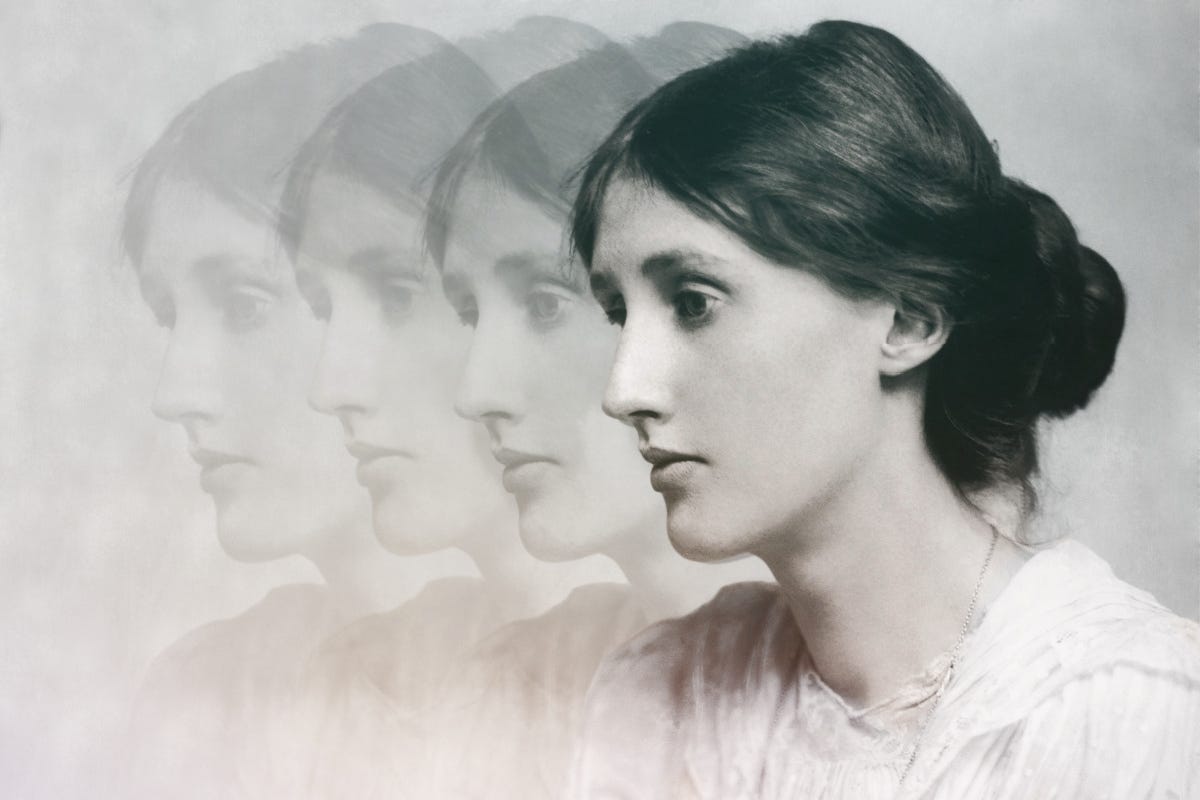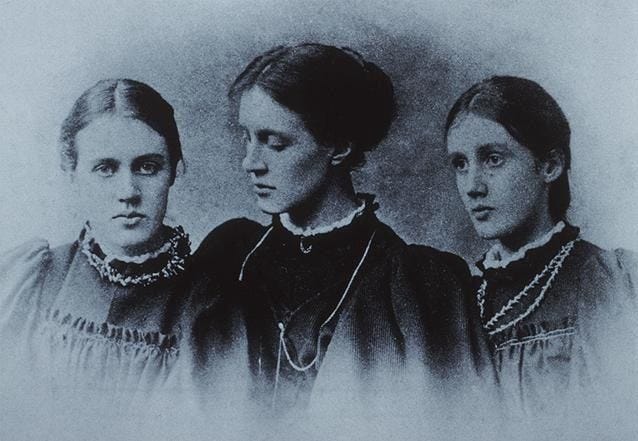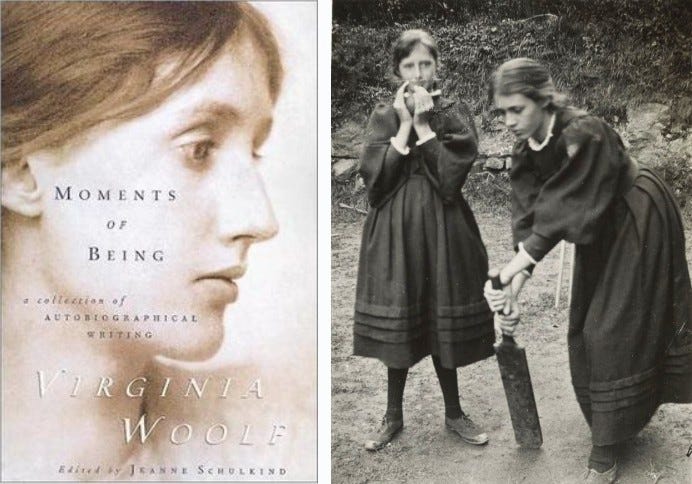Did Virginia Woolf Survive Incest?
She was mentally ill because she was allowed an education, a doctor told her father. Books were the problem. No more books.

“We write, not with the fingers, but with the whole person. The nerve which controls the pen winds itself about every fiber of our being” — Virginia Woolf
***
Virginia Woolf was a famous and successful writer. Married the love of her life and opened a publishing house together. They published not only their own writing, but other famous writers, like T.S. Eliot, E.M. Forster and Sigmund Freud.
Here’s a terrible thing we love to believe. The most creative people often struggle with mental illness, as if creativity and madness are born like conjoined twins, nevermind that a 40 year study published in the Journal of Psychiatric Research shows that creative people are not, in fact, more likely to suffer from mental illness.
But we can give examples, right?
Van Gogh. Edgar Allan Poe. Papa Hemingway and poor old broken Bukowski. Tolstoy, too. So many. Hell, Robin Williams.
That’s what they said about Virginia Woolf, too. Some still do.
Mentally ill. Always was, poor thing. Since childhood. No one takes their own life if they’re not mentally ill, right? Sane people don’t commit suicide.
It would be years before we’d know what happened. For years, we had no clue. Oh there were people who knew, make no mistake about that. But not the people judging her and writing about her.
“Life is a dream. ’Tis waking that kills us. He who robs us of our dreams robs us of our life.” — Virginia Woolf
Virginia was mentally ill because she was allowed an education, the doctor told her father…
44 years after her Virginia Woolf’s grieving husband buried her under an elm tree in the garden of Monk’s House, their home in Sussex, a collection of autobiographical essays was published. True stories of her life, it was called Moments of Being.
She was sexually assaulted at six. By her stepbrother, Gerald.
“He began to explore my body. I can remember the feel of his hand going under my clothes; going firmly and steadily lower and lower, I remember how I hoped that he would stop; how I stiffened and wriggled as his hand approached my private parts. But it did not stop. His hand explored my private parts too.” Virginia Woolf, Moments of Being (source)
Gerald was 19. She was 6. He’d set her on a narrow table across from the mirror in the front hall. The sort of table you’d toss gloves or keys, or in Gerald’s case, a small child you wish to assault.
Facing the mirror, she was forced to watch as he fondled her and opened her knickers. Afraid if she closed her eyes, she’d fall off that skinny ledge of a table.
That’s when her mental health problems started. She couldn’t look in mirrors after that. Sometimes, couldn’t bear to talk for days at a stretch.
They were a “blended” family, the Stephens and the Duckworths.
Virginia’s mother had been married before, but her husband died, leaving her with 3 children. He was the love of her life, and she grieved him even after marrying Virginia’s father, often found crying on her first husband’s grave.
There was a decade between the sets of kids. Gerald, Stella, and George Duckworth were over 10 when Virginia’s mother had four more kids with Virginia’s father. Teenagers when the abuse started.
When Virginia was 13, her mother died. Influenza. That’s when Virginia’s other stepbrother, George, started raping her. She was 13. He was 27. He’d tiptoe into her room at night. Tell her not to turn on the light. Call her his beloved. And get on top.
When she was 15, her older stepsister Stella died. That’s when Virginia learned Stella had been raped and her sister Vanessa was being raped, too. She crashed.
Black moods and nightmares. Days without talking. Writing manically in her journal about looking glass shame and feeling she was drowning, drowning, the method she would choose to finally end her pain years later.
Her father thought it was grief. She’d lost her mother and older half sister.
So he took her to a doctor.
The doctor blamed her mental illness on education. Not good for the female brain, he said. Chastised her father for letting her learn to read and write in the first place. He said books must be entirely withheld if she is to get better.
Instead, she became suicidal.
Death continued to rob her. Five years after losing Stella, Virginia’s father died. Two years later, her brother Thoby died of typhoid.
The only people in her life that didn’t seem to die was her rapists.
If you enjoy this publication, would you consider pledging your support?
A story even Sigmund Freud added pain to…

With her father and Stella gone, Vanessa, Virginia and their youngest brother left home together.
Luckily, they found their way to a literary group. The Bloomsbury Group would become a shining light in Virginia’s life, a group of writers and artists who got together to talk about writing and personal matters. To her, it was a support group. It’s where she met and married writer Leonard Woolf.
Everyone in “polite” society had talked about what a good man George Duckworth was, taking care of his half-sisters. Those poor girls. That good man. They had no idea he’d been raping both his half-sisters for years.
She spilled everything in that group. Told them what her stepbrothers were doing. To all of them. Later, doctors would say it was the best thing she did. But the effects of childhood sexual assault do not end when the rape ends and hers didn’t either.
Less than a year after marrying Leonard Woolf, she had a depressive spell so severe the doctor put her in an asylum. Same doctor who took away books at fifteen. This time, they pulled teeth, because it was believed mental illness could stem from dental problems.
When she was in her forties, Sigmund Freud became a member of the group when Virginia and Leonard published his book. Freud was hesitant to talk about her abuse. She was, after all, his publisher. And his beliefs did not favor her.
It’s one thing to talk about incest in poor families that don’t know better, he gently said. One does not talk about it in “respectable” upper income families.
“Freud was never comfortable with his discovery about the prevalence of sexual abuse and its effect because of what it implied about the behavior of respectable family men” (source)
So she started reading his work. His books and papers.
Though his beliefs have been mostly debunked today, she said it made her feel mad. He talked about hyper sexualized children with hidden desires. Was it her own fault? Did she somehow cause her own abuse? Maybe it really was all her own fault.
Two more times she was put in an asylum until she said she’d kill herself before she’d go back there. Leonard promised she would never go back. He would care for her himself. And he did. Through ups and downs, good times and bad he was her rock.
On March 28, 1941, Virginia Woolf woke up like it was any other day and went to her office. But instead of working on her manuscript, she sat down and wrote two letters. One to her sister Vanessa. The other to Leonard.
“Dearest,
I feel certain that I am going mad again. I feel we can’t go through another of those terrible times. And I shan’t recover this time. I begin to hear voices, and I can’t concentrate. So I am doing what seems the best thing to do.
You have given me the greatest possible happiness. You have been in every way all that anyone could be. I don’t think two people could have been happier ’til this terrible disease came. I can’t fight any longer. I know that I am spoiling your life, that without me you could work. And you will, I know.
You see I can’t even write this properly. I can’t read. What I want to say is I owe all the happiness of my life to you. You have been entirely patient with me and incredibly good. I want to say that — everybody knows it.
If anybody could have saved me it would have been you. Everything has gone from me but the certainty of your goodness. I can’t go on spoiling your life any longer. I don’t think two people could have been happier than we have been.
V.”
Then she walked to the River Ouse, filled her coat pockets with heavy rocks and walked into the water.
When Leonard found the letter, he ran to the river, heart racing. All he found was her walking stick laying on the ground. It would be three weeks before they found her body. She was 59 years old.
In 2014, a psychologist at the Department of Psychology, The Laboratory of Violence Analysis & Prevention (LAPREV) at the Federal University of São Carlos submitted a paper stating that the mental health symptoms experienced by Virginia Woolf are consistent with the current literature of childhood sexual abuse. (CSA)
The longest lasting emotional damage occurs when a child is abused by the age of six and the abuse continues for many years, the report said. Like Virginia.
It is not a rare problem. There are 42 million survivors of child sexual abuse alive in America right now, today.
There are almost half a million reported cases of rape every year in America. That’s only the reported cases and conventional belief is that most cases go unreported. Victims under 12 account for 15% of those raped, and 29% are between 12 and 17 and I don’t know why the numbers just won’t go down.
But at the very least, if we cannot stop rape from happening, the very least we could do is let go of the idea that mental health and creativity are joined at the hip.
Virginia Woolf wasn’t mentally ill because she was creative. She was creative despite being mentally ill.
“Each has his past shut in him like the leaves of a book known to him by his heart, and his friends can only read the title.” — Virginia Woolf
If you enjoy this publication, would you consider pledging your support?





Wow. At a loss for words. I've known of Virginia Wolff forever...but I had no idea about the longtime abuse at the hands of her 'brother'. Vaguely knew about the asylums but pulling teeth? No books? WTF? And publishing Freud - again, wow. What a tale. That she could write as eloquently as she did after such heinous childhood circumstances is nothing short of miraculous. Wow.
What do I do with the rage I feel.